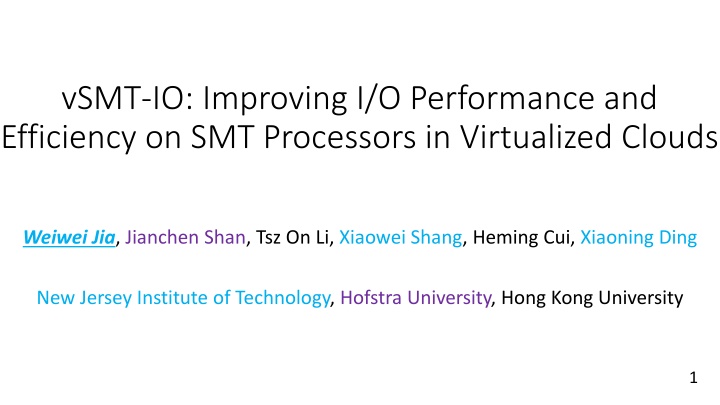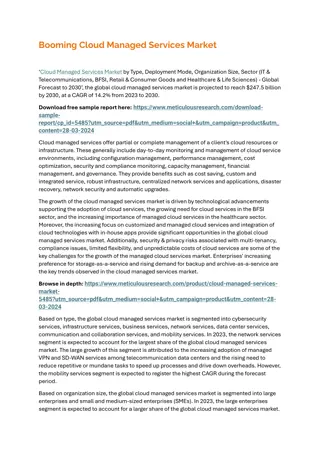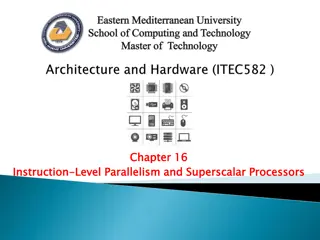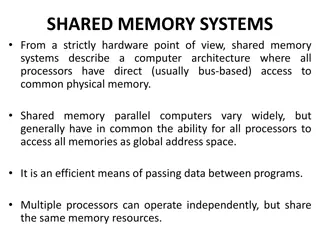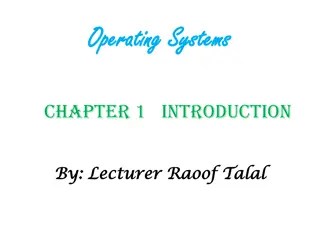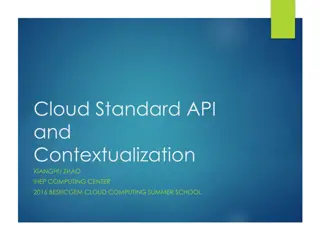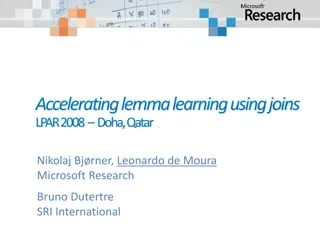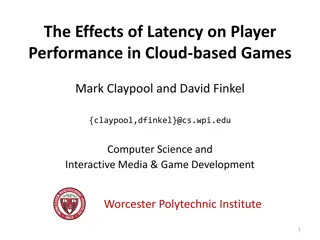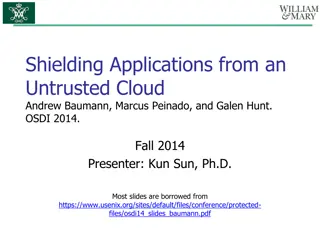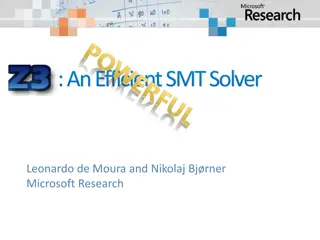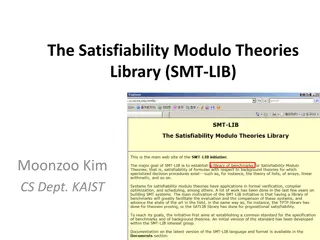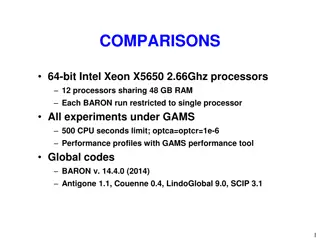Enhancing I/O Performance on SMT Processors in Cloud Environments
Improving I/O performance and efficiency on Simultaneous Multi-Threading (SMT) processors in virtualized clouds is crucial for maximizing system throughput and resource utilization. The vSMT-IO approach focuses on efficiently scheduling I/O workloads on SMT CPUs by making them "dormant" on hardware threads, resulting in significant throughput gains for both I/O and computation workloads. This innovative solution addresses the challenges of mixed I/O and computation workloads in cloud environments, enhancing system efficiency and minimizing overhead.
Download Presentation

Please find below an Image/Link to download the presentation.
The content on the website is provided AS IS for your information and personal use only. It may not be sold, licensed, or shared on other websites without obtaining consent from the author.If you encounter any issues during the download, it is possible that the publisher has removed the file from their server.
You are allowed to download the files provided on this website for personal or commercial use, subject to the condition that they are used lawfully. All files are the property of their respective owners.
The content on the website is provided AS IS for your information and personal use only. It may not be sold, licensed, or shared on other websites without obtaining consent from the author.
E N D
Presentation Transcript
vSMT-IO: Improving I/O Performance and Efficiency on SMT Processors in Virtualized Clouds Weiwei Jia, Jianchen Shan, Tsz On Li, Xiaowei Shang, Heming Cui, Xiaoning Ding New Jersey Institute of Technology, Hofstra University, Hong Kong University 1
SMT is widely enabled in clouds Most types of virtual machines (VMs) in public clouds run on processors with SMT (Simultaneous Multi-Threading) enabled. A hardware thread may be dedicatedly used by a virtual CPU (vCPU). It may also be time-shared by multiple vCPUs. Enabling SMT can improve system throughput. Multiple hardware threads (HTs) share the hardware resources on each core. Hardware resource utilization is increased. SMT Disabled SMT Enabled Figure from internet 2
CPU scheduler is crucial for SMT processors To achieve high throughput, CPU scheduler must be optimized to maximize CPU utilization and minimize overhead. Extensively studied: symbiotic scheduling focuses on maximizing utilization for computation intensive workloads (SOS[ASPLOS 00], cycle accounting[ASPLOS 09, HPCA'16], ...). Co-schedule on the same core the threads with high symbiosis levels. Symbiosis level: how well threads can fully utilize hardware resources with minimal conflicts. Under-studied: Scheduling I/O workloads with low overhead on SMT processors. I/O workloads incur high scheduling overhead due to frequent I/O operations. The overhead reduces throughput when there are computation workloads on the same SMT core. 3
Outline Problem: efficiently schedule I/O workloads on SMT CPUs in virtualized clouds vSMT-IO Basic Idea: make I/O workloads "dormant" on hardware threads Key issues and solutions Evaluation KVM-based prototype implementation is tested with real world applications Increases the throughput of both I/O workload (up to 88.3%) and computation workload (up to 123.1%) 4
I/O workloads are mixed with computation workloads in clouds I/O applications and computation applications are usually consolidated on the same server to improve system utilization. Even in the same application (e.g., a database server), some threads are computation intensive, and some other threads are I/O intensive. The scheduling of I/O workloads affects both I/O and computation workloads. High I/O throughput is not the only requirement. High I/O efficiency (low overhead) is equally important to avoid degrading throughput of computation workloads. 5
Existing I/O-Improving techniques are inefficient on SMT processors To improve I/O performance, CPU scheduler increases the responsiveness of I/O workloads to I/O events. Common pattern in I/O workloads: waiting for I/O events, responding and processing them, and generating new I/O requests. Respond to I/O events quickly to keep I/O device busy. Existing techniques in CPU scheduler for increasing I/O responsiveness Polling(Jisoo Yang et. al. [FAST 2012]): I/O workloads enter busy loops while waiting for I/O events. Priority boosting (xBalloon [SoCC 2017]): Prioritize I/O workloads to preempt running workloads. Incur busy-looping and context switches and reduce resources available to other hardware threads. 6
Polling and priority boosting incur higher overhead in virtualized clouds Polling on one hardware thread slows down the computation on the other hardware thread by about 30%. Execute repeatedly instructions controlling busy-loops. Incur costly VM_EXITs because polling is implemented at the host level. Switching vCPUs incurred by priority boosting on one hardware thread may slow down the computation on the other hardware thread by about 70%. Save and restore contexts Execute of scheduling algorithm Flush L1 data cache for security reasons Handle rescheduling inter-processor interrupts (IPIs) 7
Outline Problem: efficiently schedule I/O workload on SMT CPUs in virtualized clouds vSMT-IO Basic Idea: make I/O workloads "dormant" on hardware threads Key issues and solutions Evaluation KVM-based prototype implementation is tested with real world applications Increases the throughput of both I/O workload (up to 88.3%) and computation workload (up to 123.1%) 8
Basic idea:make I/O workloads "dormant" on hardwarethreads Motivated by the hardware design in SMT processors for efficient blocking synchronization (D.M. Tullsen et. al. [HPCA 1999]). Key technique: Context Retention, an efficient blocking mechanism for vCPUs. A vCPU can block on a hardware thread and release all its resources while waiting for an I/O event (no busy-looping). High efficiency: other hardware threads can get extra resources. The vCPU can be quickly unblocked without context switches upon the I/O event. High I/O performance: I/O workload can quickly resume execution. High efficiency: no context switches involved. Implemented with MONITOR/MWAIT support on Intel CPUs. 9
Issue #1: uncontrolled context retention can diminish the benefits from SMT Context retention reduces the number of active hardware threads on a core. On x86 CPUs, only one hardware thread remains active, when the other retains context. Delay the execution of computation workloads or other I/O workloads on the core. Uncontrolled context retention may be long time periods. Some I/O operations have very long latencies (e.g., HDD seeks, queuing/scheduling delays). Solution: enforce an adjustable timeout on context retentions. Timeout interrupts context retentions before they become overlong. Timeout value being too low or too high reduces both I/O performance and computation performance. Value too low: context retention is ineffective (low I/O performance); high overhead from context switches (low computation performance). The timeout value is adjusted dynamically (algorithm shown on next page). 10
Start from a relatively low value Gradually adjust Gradually adjust timeout value timeout value . . . If new value can improve both I/O and computation performance 11
Issue #2: existing symbiotic scheduling techniques cannot handle mixed workloads To maximize throughput, scheduler must co-schedule workloads with complementary resource demand. The resource demand of I/O workloads change dramatically due to context retention and burstiness of I/O operations. Existing symbiotic scheduling techniques target steady computation workloads and precisely characterize resource demand. Solution: target dynamic and mixed workloads and coarsely characterize resource demand based on the time spent in context retention. Rank and then categorize vCPUs based on the amount of time they spend on context retention. Category #1: Low retention --- vCPUs with less context retention time are resource-hungry. Category #2: High retention --- vCPUs with more context retention time consume little resource. vCPUs from different categories have complementary resource demand and are co-scheduled on different hardware threads. A conventional symbiotic scheduling technique is used only when all the ``runnable vCPUs are in low retention category. 12
Other issues Issue #3: context retention may reduce the throughput of I/O workloads since it reduces the timeslice available for their computation. Solution: Timeouts (explained earlier) help reduce the timeslice consumed by long context retentions. Compensate I/O workloads by increasing their weights/priorities. Issue #4: the effectiveness of vSTM-IO reduces when the workloads become homogeneous on each core. Solution: Migrate workloads across different cores to increase the workload heterogeneity on each core. Workloads on different cores may still be heterogeneous. E.g., computation workloads on one core, and I/O workloads on another core. 13
vSMT-IO Implementation Co-schedule vCPUs based on their time spent in context retention (Implemented in Linux CFS) Retention-Aware Symbiotic Scheduling schedule system component workload info. Implement context retention and adjust timeout CPU-bound vCPU I/O-bound vCPU monitor Maintain workload heterogeneity on each core (Implemented in Linux CFS and Linux idle threads) data Workload Monitor control & management migrate . . . . . . . . . Workload Adjuster workload info. perf. info. timeout . . . . . . workload info. Long Term Context Retention Core 0 Core 1 14
Outline Problem: efficiently schedule I/O workload on SMT CPUs in virtualized clouds vSMT-IO Basic Idea: make I/O workloads "dormant" on hardware threads Key issues and solutions Evaluation KVM-based prototype implementation is tested with real world applications Increase the throughput of both I/O workload (up to 88.3%) and computation workload (up to 123.1%) 15
Experimental Setup Dell PowerEdge R430 with 24 cores (48 HTs), a 1TB HDD, and 64GB DRAM. Both VMs and VMM (Linux QEMU/KVM) use Ubuntu Linux 18.04 with kernel version updated to 5.3.1. Each VM has 24 vCPUs and 16GB DRAM. Compared with three competing solutions Priority boosting (implemented in KVM with HALT-Polling disabled) Polling (implemented by booting guest OS with parameter ``idle=poll configured) Polling with a dynamically adjusted timeout (implemented by enhancing KVM HALT-Polling) Test under two settings Each vCPU has a dedicated hardware thread. Each hardware thread is time-shared by multiple vCPUs. 16
Evaluation applications and workloads Application Workload Redis Serve requests (randomly chosen keys, 50% SET, 50% GET) HDFS Read 10GB data sequentially with HDFS TestDFSIO Hadoop TeraSort with Hadoop HBase Read and update records sequentially with YCSB MySQL OLTP workload generated by SysBench for MySQL Nginx Serve web requests generated by ApacheBench ClamAV Virus scan a large file set with clamscan RocksDB Serve requests (randomly chosen keys, 50% SET, 50% GET) PgSQL TPC-B like workload generated by PgBench Spark PageRank and Kmeans algorithms in Spark DBT1 TPC-W like workload XGBoost Four AI algorithms included in XGBoost system Matmul Multiply two 8000x8000 matrices of integers Sockperf TCP ping-pong test with Sockperf 17
Evaluation objectives To show vSMT-IO can improve I/O performance with high efficiency and benefit both I/O workloads and computation workloads. To verify the effectiveness of the major techniques used in vSMT-IO. To understand the performance advantages of vSMT-IO across diverse workload mixtures and different scenarios. To evaluate the overhead of vSMT-IO 18
Throughputs of eight benchmark pairs (one vCPU on each hardware thread) *Throughputs are relative to priority boosting (shown with horizontal line at 100%) 19
Throughputs of eight benchmark pairs (one vCPU on each hardware thread) vSMT-IO and polling achieve similar I/O throughput. 20
Throughputs of eight benchmark pairs (one vCPU on each hardware thread) I/O workload throughput increased by 46% relative to priority boosting and by 28% relative to polling with timeout. 21
Throughputs of eight benchmark pairs (one vCPU on each hardware thread) Throughput of computation workload (Matmul) increased by 38%, 15% and 28%, respectively, relative to Polling, priority boosting and polling with timeout. 22
Throughputs of eight benchmark pairs (two vCPUs time-share a hardware thread) * Throughputs are relative to priority boosting (shown with horizontal line at 100%). I/O workload throughput increased by 30% relative to polling with timeout Computation workload throughput increased by 18% relative to priority boosting. 23
Analyzing performance Improvement with DBT1 and MultipleClassify * Throughputs are relative to priority boosting (shown with horizontal line at 100%). 24
Analyzing performance Improvement with DBT1 and MultipleClassify Number of vCPU switches per second Priority boosting Polling with timeout vSMT-IO 61.3k 29.5k 3.9k 25 25 25
Analyzing performance Improvement with DBT1 and MultipleClassify Number of vCPU switches per second Time (%) spent on hyper-threads for I/O bound vCPUs Context Retention I/O Workload Computation workload Priority boosting Polling with timeout vSMT-IO 32.7% 54.4% 12.9% 61.3k 29.5k 3.9k 26
Response times of seven benchmarks (two vCPUs time-share a hardware thread) * Response times are relative to priority boosting (shown with horizontal line at 100%). Response times are reduced by 51% relative to priority boosting and by 29% relative to polling with timeout. 27
vSMT-IO reduces response time by reducing scheduling delay of vCPUs DBT1 Priority boosting Polling w/ timeout vSMT-IO Time spent (ms) by vCPUs in ready state 1831.4 842.9 643.2 Time spent (ms) by vCPUs in waiting state 1390.2 1035.8 641.6 * Response times are relative to priority boosting (shown with horizontal line at 100%). 28
Conclusions How to improve I/O performance and efficiency on SMT processors is under-studied. Existing techniques used by CPU schedulers are inefficient. Such inefficiency makes it hard to achieve high CPU and I/O throughputs. vSMT-IO is an efficient solution for scheduling I/O workloads on x86 virtualized clouds. Context retention uses a hardware thread to hold the context of an I/O workload waiting for I/O events. Two key issues: 1) uncontrolled context retention can diminish the benefits from SMT; 2) existing symbiotic scheduling techniques cannot handle mixed workloads. Evaluation shows vSMT-IO can substantially increase both CPU throughput and I/O throughput. 29
References [1] Snavely, Allan, and Dean M. Tullsen. "Symbiotic jobscheduling for a simultaneous multithreaded processor." Proceedings of the ninth international conference on Architectural support for programming languages and operating systems. 2000. [2] Stijn Eyerman and Lieven Eeckhout. Per-thread cycle accounting in SMT processors. Proceedings of the 14th international conference on Architectural support for programming languages and operating systems (ASPLOS XIV). 2009. [3] Feliu, Josu , et al. "Symbiotic job scheduling on the IBM POWER8." 2016 IEEE International Symposium on High Performance Computer Architecture (HPCA). IEEE, 2016. [4] Yang, Jisoo, Dave B. Minturn, and Frank Hady. "When poll is better than interrupt." FAST. Vol. 12. 2012. [5] Suo, Kun, et al. "Preserving I/O prioritization in virtualized OSes." Proceedings of the 2017 Symposium on Cloud Computing. 2017. [6] Tullsen, Dean M., et al. "Supporting fine-grained synchronization on a simultaneous multithreading processor." Proceedings Fifth International Symposium on High-Performance Computer Architecture. IEEE, 1999. 30
Thank you! Questions? 31
